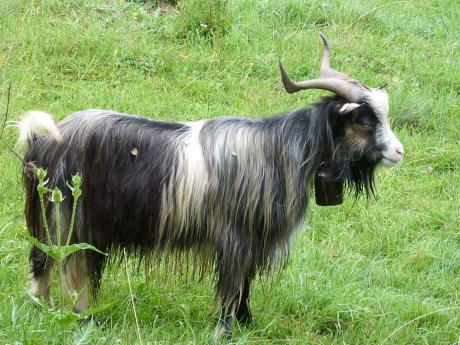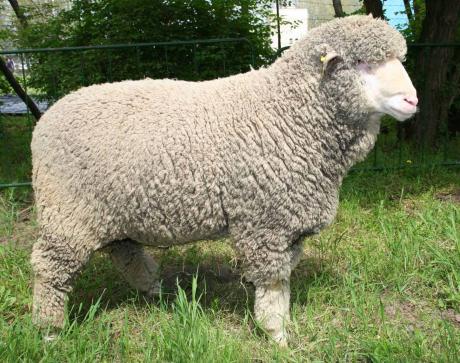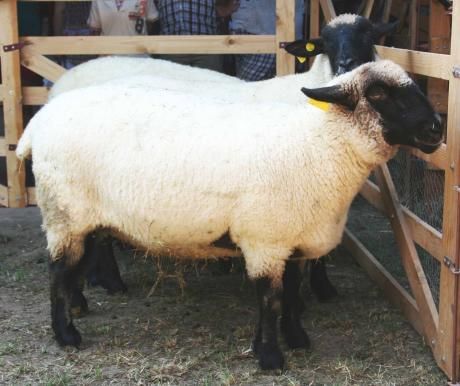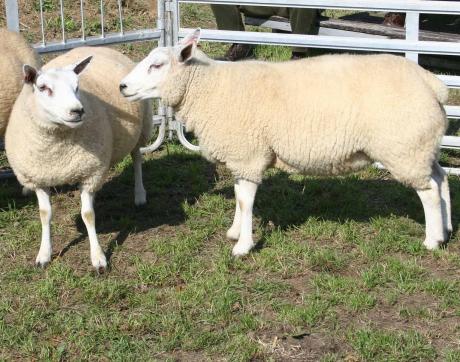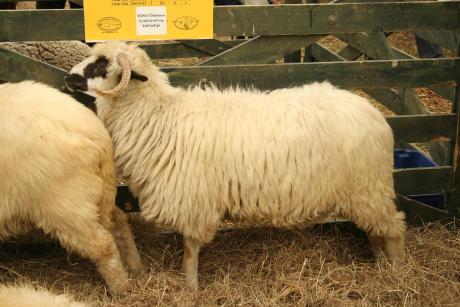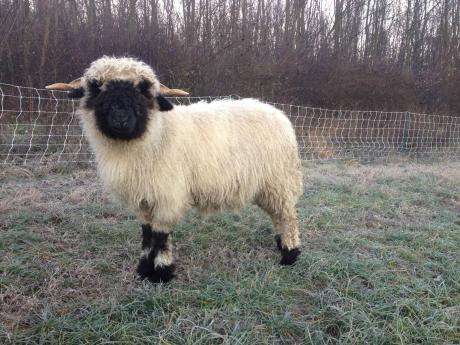Goat breeds
Mutton Breeds
Boar Goat
It is a meat purpose goat breed with South African origin. They are large, muscular animals with short hair, white base colour and red neck and head. Their bridge of nose is curved, often having a blaze on it. They have long and pendulous lop-ears Both sexes are horned. Their age at first mating is 10 to 12 months. They are non-cycling animals with placid temperament and excellent maternal traits. They are recommended to be kept based on grazing land. They have an average progeny of 1.8 per kidding and a milk yield of 300 to 500 kg. Their weight gain is intensive, and their carcass dressing percentage is better than 50%. Their meat shapes (meat conformation) are excellent, and their meat is tasty and lean. Their excellent traits appear also in crossing programmes well.
Dairy Breeds
Alpine
The breed comes originally from Switzerland, but under the name of Alpine it has become a worldwide spread goat breed starting from France. They are fine build, and their conformation refers to a pronounced dairy character. Their hair is short in length and most often sandy in colour with some black along the spine. Due to their vivacious temperament they bear being kept in fold less. They have proved good under semi-intensive conditions, and they adapt themselves suitably to the grazing technology. With appropriate raising they can be first mated at the age of 7 to 12 months. They have an average progeny of 1.7 per kidding. Under good conditions their milk yield can be 1000-1200 kg over a lactation period of 270 to 300 days.
Anglo-Nubian
The Nubian /Anglo-Nubian breed was developed by crossing Egyptian Zairaibi and Indian Jamnapari or Jamunapari bucks with English dairy goats. Under the latter name, only those ones are registered in the flock-book, which are from the original British bloodline. Their outward appearance is characterised mainly by their long legs, large body, wide pendulous lop-ears and convex nasal bone. Their hair is short, the predominance of reddish brown or black is typical of their colouring, however the most varied combinations of colours may occur. They may either be horned or polled. Their age at first mating is 10 to 12 months. Friendly behaviour and well-balancedness are characteristic of them. Due to their high environmental and feeding needs, this breed is recommended to be kept mostly with intensive technology or as a hobby animal. Under good conditions their milk yield can be 1000-1200 kg over a lactation period of 300 days, with a fat content of 4.8% and protein content of 3.8%.
Saanen
The cradle of this breed is the Saanen Valley in Switzerland. Today, it is the most known milk purpose goat breed in the world. They are characterized by strong, robust physique. Their hair is short, uniformly white in colour, some yellowish tints may occur. They have a placid temperament and bear being kept in fold well. They can be reared also with grazing technology, but they are capable of doing a really high production under intensive conditions. With appropriate raising the kids can be first mated at the age of 7 to 12 months. They have an average progeny of 1.7 per kidding. Under good conditions their milk yield can be 800-1000 kg over a lactation period of 270 to 300 days.
Indigenous Breeds
Magyar parlagi kecske / Old Hungarian Goat / Hungarian Plain Goat
Under this name the native goat breed developed in the Carpathian Basin, partly bearing the outward stamps of goats came to Hungary during the period of the great migrations are mentioned. The standardization of the breed’s outward appearance is still under way. The dominant feature is that the hair length of the adult animals shall be at least 10 cm, which covers the entire body (with curly locks) and the body part behind the arch of the ribs (rough-legged). This feature shall be inheritable to their descendants. With the exception of brown body with dark back strap, they may have any colour variation and any colour combination. They may either be horned or polled. The horned males have outward-curved horns Their age at first mating is 7 to 12 months. Some she-goats may be capable of significant milk production, however the primary goal is not to achieve a high milk yield, but the gene conservation, to maintain their sturdy constitution and high resistance.
Sheep breeds
Merino Breeds
German Mutton Merino
It is a white mutton sheep breed with coarser bones than the Hungarian Merino. Their conformation is comparable to the ideal meat shapes (mutton conformation). Progeny of 1.3 to 1.4 is typical of the breed. However in order to be able to raise their lambs without any problems, appropriate emphasis shall be put on lambing preparation and ensuring milk production necessary for lamb rearing. They are inclinable to out-of-season breeding. The lambs have good (340-380 g) weight gaining ability, excellent feed consumption indexes and attractive meat shapes (mutton conformation). Mature weights for ewes range from 60 to 80 kg, and ram weights vary from 90 to 125 kg.
Magyar Merino / Hungarian Merino
It is a breed well-adapted to domestic climatic conditions, originally with dual - triple purpose (wool, meat, milk). However currently meat production shall be considered as the main source of gains, so the objective is to improve prolificacy and lamb rearing ability. It is a white Merino breed showing average meat shapes (mutton conformation). They are characterized by moderately long body length, fleece covered abdomen and legs, and heads overgrown to the eyeline. Their prolificacy ranges from 1.3 to 1.5, and the weight gain is 300-350 g/day. Mature weights for ewes range from 54 to 58 kg, and ram weights vary from 85 to 100 kg. The fineness of fleece is 18 to 26 microns.
Merinolandschaf
It is a large, well-muscled merino breed. They resist the rigours of weather well and can go about large areas. Their prolificacy ranges from 1.5 to 1.8, the lamb rearing ability is excellent, and they bear accelerated lambing and early first mating well. In some countries this breed is known as Württemberger sheep. Weights for adult rams range from 100 to 125 kg, and ewe weights vary from 70 to 80 kg.
Mutton Breeds
Berrichon du Cher
It is a single purpose white mutton breed with good grazing behaviour. They are characterized by good maternal traits, a good milk yield and a prolificacy of 1.4 to 1.6. The breed has the inclination to out-of-season breeding. At their place of origin 60% of ewes lamb between September and November. The ewe lambs can be first mated at the age of 10 to 12 months, however also the long useful production can be observed at this breed. They are characterized by good meat shapes (mutton conformation) and 320 to 370 g average daily gain (ADG) of lambs. Mature weights for ewes range from 70 to 90 kg, and ram weights vary from 90 to 130 kg.
Blanche du Massif Central (BMC)
It is a single purpose white mutton breed with good grazing behaviour. They are characterized by good maternal traits, a good milk yield and a prolificacy of 1.4 to 1.6. The females of this breed can be lambed also out of the season. The ewe lambs can be first mated at the age of 10 to 12 months, and in the case of appropriate feeding it does not have a negative effect on their life performance. They are characterized by good meat shapes (mutton conformation) and 300 to 350 g average daily gain (ADG) of lambs. Mature weights for ewes range from 60 to 80 kg, and ram weights vary from 90 to 140 kg.
Blue-headed Mutton Sheep / Bleu du Maine
This breed originates from crossing local sheep kept in the departments (counties) of Maine-et-Loire, Mayenne and Sarthe in France with British mutton breeds (such as Kent, Leicester, Wensleydale). Its breeding society was founded in 1927, and its flock-book was started in 1938. The breed has good grazing behaviour and resistance to diseases, as well as they bear being kept also in fold well. This early maturing mutton breed is a seasonal breeder with good milk yield. The weight gain of lambs is particularly good. Their prolificacy ranges from 1.8 to 2.0. The breed is characterized by easy lambing. Their lamb rearing ability is excellent. Mature weights for ewes range from 80 to 95 kg, and ram weights vary from 100 to 130 kg.
Charollais
It is a fine boned, single purpose, white mutton breed. The Charollais has excellent maternal traits, high progeny of 1.7 to 1.8 and an excellent milk yield. They are early maturing seasonal breeders; the ewe lambs can be mated from the age of 7 months. The Charollais lambs can be characterized by good meat shapes (mutton conformation). They have high growth vigour and reach or exceed a weight of 25 kg by the age of 70 days. In commercial crossing, the lambs from Charollais rams show a slight fat level (desirable proportion of fat and lean) even at a weight of 40 kg. The weight gain of lambs ranges from 350 to 400 g. Mature weights for ewes range from 70 to 80 kg, and ram weights vary from 90 to 110 kg.
Dorper
It was developed in South Africa by crossing the Dorset Horn and the Blackhead Persian. The colour of the Dorper is white, greyish-white on their body and legs, while their head and upper neck is black. It is a hair sheep breed, i.e., they shed their fur for the most part, so there is no shearing required. They are out-of-season breeders, suitable for accelerated lambing, with a prolificacy of 160 to 180%. They have a placid temperament, and their maternal traits are particularly good. Their grazing behaviour and resistance are good, and they resist drought. The average daily gain (ADG) of lambs ranges from 350 to 450 g. Mature weights for ewes range from 75 to 80 kg, and ram weights vary from 90 to 110 kg.
English Suffolk
It has been recognized as a distinct breed since 1810. It is counted among the so-called ‘Down’ group of breeds, almost each of which is characterized by black or dark face and legs. In the United Kingdom it is the most commonly used paternal breed (terminal sire). Two-thirds of slaughter lambs produced in the country are from Suffolk rams. They are characterized by excellent maternal traits, a good milk yield and a prolificacy of 1.5 to 1.8. They are seasonal breeders. It is one of the breeds having the best grazing behaviour, however they bear also being kept in fold well. They show good meat shapes (mutton conformation) and have high lamb weight gain. Mature weights for ewes range from 75 to 90 kg, and ram weights vary from 100 to 130 kg.
German Blackheaded Mutton
It is s strong-boned mutton breed with good grazing behaviour. The head and the legs have a matte black colour. This breed has good maternal traits, Their prolificacy ranges from 1.5 to 1.7. They are characterized by a high (360-400 g) average daily gain (ADG) of lambs. When they are used in a merino flock for retupping, even the lambs born at the end of the lambing season will reach the market weight without any problem. Their inclination to out-of-season breeding is low, but under the keeping conditions in Hungary a part of the livestock can be mated also out of the season. Mature weights for ewes range from 70 to 90 kg, and ram weights vary from 100 to 130 kg.
Hampshire
The breed belonging to the Down group of breeds was originally developed by crossing the Southdowns with the Wiltshire Horn and the now extinct Berkshire Knot in the 19th century, in the southern part of England and the shire county of Hampshire. Later on it was improved by using Cotswold and large-sized Southdown rams. This mutton breed is a seasonal breeder with good grazing behaviour. The weight gain of lambs is high, their mutton becomes fatty late (showing a desirable proportion of fat and lean). Their prolificacy ranges from 1.5 to 1.8. The breed is characterized by easy lambing. Their lamb rearing ability is excellent. Mature weights for ewes range from 70 to 90 kg, and ram weights vary from 110 to 140 kg.
Ile-de-France
It is a white breed with attractive meat shapes (mutton conformation), related to the Merinos. They are characterized by good maternal traits and progeny of 1.4 to 1.8. Their inclination to out-of-season breeding is good, and they can be mated at any time of the year, unlike many mutton breeds. The lambs have a good weight gaining ability (320-360 g). Mature weights for ewes range from 70 to 90 kg, and ram weights vary from 100 to 140 kg.
Romney
The breed has been developed in the counties of Kent and Sussex in England since the 13th century. It is a long wool, true dual purpose breed producing well under extensive conditions. They are distinctly seasonal breeders. Due to their special claw structure, they are resistant to foot rot, and do not require hoof care. Easy lambing and progeny of 1.3 to 1.7 are typical of the breed. The fineness of fleece is 30-40 microns. Mature weights for ewes range from 50 to 70 kg, and ram weights vary from 80 to 100 kg.
Shropshire
It is a single purpose mutton breed with good grazing behaviour as well as black face and legs. A peculiarity of the breed is that they do not damage coniferous trees, buds, the bark of fruit trees and vine stocks, consequently this breed is recommended to be used to keep nurseries, orchards and vineyards weed-free. They are characterized by good maternal traits, good milk performance and a prolificacy of 1.7 to 2.0. They are characterized by good meat shapes (mutton conformation) and 350 to 400 g average daily gain (ADG) of lambs. Mature weights for ewes range from 60 to 80 kg, and ram weights vary from 100 to 125 kg.
Southdown
It is one of the oldest English breeds, having been developed for centuries in the shire county of Sussex in England. More than 200 years ago, John Ellman set to the radical improvement of the breed by selectively breeding them within the flock. It was the basis of almost the whole Down group of breeds. The popularity of the breed was at its peak from the mid-19th century to World War I. This mutton breed is also an out-of-season breeder with good grazing behaviour. The weight gain of lambs is high, their mutton becomes fatty late (showing a desirable proportion of fat and lean). Their prolificacy ranges from 1.5 to 1.8. The breed is characterized by easy lambing. Their lamb rearing ability is good. Mature weights for ewes range from 55 to 70 kg, and ram weights vary from 70 to 90 kg.
Suffolk
It is a large growing, strong-boned, single purpose mutton breed with good grazing behaviour. Their head and legs are covered with fine, shiny black hairs. They are characterized by excellent maternal traits, a good milk yield and a high prolificacy of 1.6 to 1.8. A part of the livestock in Hungary has the inclination to out-of-season breeding. It is one of the breeds having the best grazing behaviour, however they bear also being kept in fold very well. They are characterized by good meat shapes (mutton conformation) and high, 350 to 400 g average daily gain (ADG) of lambs. Mature weights for ewes range from 75 to 90 kg, and ram weights vary from 90 to 130 kg.
Texel
It is a medium growing, medium to large sized, strong-boned, white mutton breed. They have excellent meat shapes (mutton conformation), both fore and hind quarters have remarkable muscle development. It is a ‘four-leg-ham’ type. The S/EUROP carcass classification system was developed on the basis of the Texel breed. The average daily gain (ADG) of lambs is 320 to 380 g. They have good maternal traits. Their prolificacy ranges from 1.5 to 1.7. They are characterized by good milk yield and lamb rearing ability. They are seasonal breeders with medium maturation. Mature weights for ewes range from 60 to 70 kg, and ram weights vary from 90 to 100 kg.
Vendéen / Mouton Vendéen
It is bred in France, mainly in the western part of the country and in the Massif Central region. This breed with strong constitution and high meat performance tolerates both hot summers and cold winters. As terminal sire it improves daily weight gain, feed conversion and the bone-meat ratio. It is a single purpose mutton breed definitely well adapted to different technological conditions. The ewes are inclinable to out-of-season breeding. Their prolificacy ranges from 1.7 to 1.9. The breed is characterized by easy lambing. Their lamb rearing ability is excellent. The breed has good grazing behaviour and good weather resistance. They have excellent meat shapes (mutton conformation). Mature weights for ewes range from 60 to 80 kg, and ram weights vary from 100 to 120 kg.
White Dorper
It was developed in South Africa by crossing the Dorper and the Afrikaner sheep. Their colour is white, while claws, under tail area and udder teats are pigmented. It is a hair sheep breed, i.e., they shed their fur for the most part, so there is no shearing required. They are out-of-season breeders, suitable for accelerated lambing, with a prolificacy of 160 to 180%. They have a placid temperament, and their maternal traits are very good. Their grazing behaviour and resistance are good, and they resist drought. The average daily gain (ADG) of lambs ranges from 350 to 450 g. Mature weights for ewes range from 75 to 80 kg, and ram weights vary from 90 to 110 kg.
White Suffolk
The breed has been developed for the extreme Australian conditions since the 1970s, conducted by Professor Ewan Roberts. The Suffolk breed was crossed with white breeds. The Poll Dorset (hornless) and the Border Leicester were the main crossing breeds. They show excellent production results under arid and semi-desert conditions, but also in rainy zones. They are able to have particularly good weight gain even under extensive conditions, kept on grazing land. They are characterized by strong bone structure, balanced frame and excellent meat shapes (mutton conformation). Their maternal traits, such as milk performance, prolificacy and easy lambing, are excellent. They can be mated, lambed all year round. The lambs show a beneficial fat level (proportion of fat and lean) even at a higher slaughter weight. Pursuant to their meat performance, this bread has become the leading terminal sire in Australia. Their prolificacy ranges from 1.6 to 1.9. Mature weights for ewes range from 70 to 90 kg, and ram weights vary from 100 to 140 kg.
Prolific Breeds
Bábolna Tetra / Prolific Bábolna
It is a white, Hungarian, prolific breed developed from the Hungarian Merino, the Romanov and the Finnish Landrace. They have fine stature and bone structure, vivacious temperament and sturdy constitution. Both sexes are hornless. This breed can mate and breed in all seasons of the year with the ability to produce 1.7 lambs per lambing. It can be bred profitably both in pure gene and as a crossing breed. The weight gain of lambs is 200 to 300 g. Weights for ewes range from 50 to 55 kg, and ram weights vary from 65 to 75 kg.
Romanov
This breed developed in Russia, being fine in stature and yet having robustious and sturdy constitution got the name Romanov from the town of the same name in the Upper Volga region. Their body is covered by mixed fur coat composed of glossy black, straight or rarely wavy guard hairs of primary origin and wavy or curly, silvery white down hairs of secondary origin being about twice as long as the former. On their head and legs and at the end of their tail there are spots in various sizes. The rams and rarely also the ewes have long-stapled, black, mane-like hair formation on their clod till the withers, on the edge of their tail and occasionally in their cingulum region. The Romanov lambs are usually pure black when they are born, with white markings on their head and at the end of their tail. The have remarkable prolificacy. Twin and triple lambing is regular. Four lambs in a litter are common. Moreover they can be lambed twice a year.
Dairy Breeds
British Milk Sheep
This breed was developed during the 70-80s in England from the Lleyn of Wales using mainly the East Friesian and other breeds (the Dorset, the Bluefaced Leicester, etc.). They are used first of all in crossings to improve prolificacy and lamb rearing ability, however their weight gain is also beneficial (over 300 g). Their milk yield is excellent. They can give 150 to 400 litres of milk over a more than 200-day lactation. Weights for ewes range from 50 to 60 kg, and ram weights vary from 80 to 90 kg.
East Friesian / Friesian Milk Sheep
This breed was developed in the 19th century in the grass-rich coastal region between Northern Germany and the English Channel. It has been a distinct breed since 1892. It has been under production control since 1926. They like good grazing lands, humid climate and small flock husbandry. It is an intensive breed requiring great care. In Hungary they are maladjusted to the arid climate, poor grazing lands and large flock husbandry conditions. They have rapid development and can be lambed by the age of 1 year. This breed is considered to be the world’s highest producing dairy sheep. In Germany, after the lambs are weaned at 4 to 8 weeks old, the East Friesian produces 500-700 kg, in good stocks 1200 kg of milk over a 260-day lactation. They are an excellent crossing breed to improve milk yield, to breed other dairy sheep and to develop intensive dairy stocks. Their prolificacy ranges from 2.2 to 2.5. They raise their 2 to 3 lambs safely. Mature weights for ewes range from 70 to 90 kg, and ram weights vary from 100 to 120 kg.
Lacaune
This breed is the most known French dairy sheep. ‘Roquefort’ cheese is produced from the milk of this breed. Their milk yield rages from 200 to 400 litres. This medium-sized, fine-boned breed has short fleece only on the dorsal part of neck up to the middle of side. The advantage of the Lacaune over other dairy breeds is that their meat shapes (mutton conformation) and weight gain (320-400 g) are comparable with the mutton breeds. Their inclination to out-of-season breeding is excellent. They can be mated at any time of the year with special regard to the period from April to May. Mature weights for ewes range from 50 to 60 kg, and ram weights vary from 90 to 100 kg.
Indigenous Breeds
Alföldi Suta Racka Sheep
The Alföldi Suta Racka (polled Zackel) was the typical native sheep breed of the world of small farms in the southern part of the Great Hungarian Plain (Alföld) still for a few years after World War II. Usually they were kept in smaller flocks of 15 to 50 sheep in the farmsteads respectively. However in holdings with more grazing lands they were in larger flocks of 70 to 100 sheep. In Hódmezővásárhely the course of breeding was set by this breed developed from Hungarian and ‘csákovai’ (Ciacova) sheep. Back in 1946, the Hódmezővásárhelyi Állattenyésztési Egyesület Juhtenyésztési Szakosztálya (Sheep Breeding Section of Animal Breeding Association in Hódmezővásárhely) pointed out that 90 percent of sheep in Vásárhely was Racka. It is a triple purpose sheep breed. Milk and mutton play part in supplying with food, while fur and felt have role in clothing. As an apt wording says: “As long as there will be peasants on the back of the Earth, sheepskin coats, fur trimmed spencer and lambskin hats will be always needed!”
Cigája / Tsigai
The Tsigai is a transboundary sheep breed that came to the territory of Hungary from the Balkan Peninsula at the end of the 18th century. It is a medium sized breed. Their face and legs are black, dark brown or brown. The fleece is white but interlarded with coloured threads. The ewes are hornless or bear crescent horns. The rams are partly hornless and partly have strong open spiral horns describing one and a half curls. Their lamb weight gain is favourable, 300 to 350 g/day. Weights for ewes range from 50 to 60 kg, and ram weights vary from 75 to 90 kg.
Cikta
The presently known Cikta descends from the Zaupelschaf widely spread in the mediaeval Central Europe, which was a small sheep with curly mixed fleece. They were out-of-season breeders and lambed often two lambs. The breed was brought to Hungary by the German-speaking population arriving during the settlements after Ottoman rule. First of all they spread in Tolna and Baranya Counties, because of this the breed was called also the Swabian sheep of Tolna-Baranya. Owing to their undemanding nature and their wool used in the cottage industry this sheep breed was common in the household farming plots. The conservation programme of this breed has been carried out by breeding less than 100 animals. Despite the consistent and persistent breeding work, this breed is still endangered. The registered livestock consists of about 800 sheep. Nowadays this breed is becoming more and more popular, because with a relatively small investment they raise showy, healthy lambs based on grazing. Their mutton is tasty and lean. The Cikta is an ideal small acreage or backyard breed to raise. They can be recommended to maintain larger yards, areas covered in grass.
Gyimesi racka / Transylvanian Racka / Transylvanian Zackel
The Transylvanian Racka from Gyimes (Ghimeș) bred in Transylvania belongs to Zackel type of sheep breeds. It is the largest sheep breed in the group of Zackel breeds. Mature weights for ewes range from 45 to 50 kg, and ram weights vary from 80 to 90 kg. The ewes have crescent horns or short vestigial horns, however there are many polled ones. The rams bear regular, open-spiral-shaped horns with 1.5 to 2.25 curls. The Transylvanian Racka has white fur, but black tints on the head and legs are very frequent appearing as spots around the eyes (eyespot) and the mouth, on the ears and at the ends of the legs. Their fur is mixed fleece composed of guard hairs and down hairs with a staple length of 30 to 40 cm. In Transylvania milk production is the main purpose of their use.
Hortobágyi Racka / Hungarian Racka / Hungarian Zackel (white, black)
The Hungarian Racka of Hortobágy is known for their unique spiralling, corkscrew shaped horns possessed by both sexes. The horns protrude upward from the top of the head in a V-shape for the ewes and in a wider angle for the rams. The average length of horns is 30 cm for ewes and 50 cm for rams. It is a relatively small breed with long, floor-length, curly, coarse fleece. Two colour types, black and white, are bred strictly separated. Their head and legs are covered with short, shiny brown or black hairs. Their temperament is vivacious. Their lamb weight gain is low, 150 to 250 g/day. Weights for ewes range from 35 to 45 kg, and ram weights vary from 55 to 75 kg.
Sárgafejű berke / Yellow-headed Tsigai
It is an extensive breed bred in Transylvania, first of all in the counties of Kovászna (Covasna) and Hargita (Harghita), however it can be found also in Hungary, in the vicinity of Kecskemét. It belongs to the group of Tsigai sheep breeds. The so-called ‘bald-bellied’ (bare-bellied) variation is a separate type. The prolificacy of the breed ranges from 1.2 to 1.4, and their milk yield in a lactation is between 80 and 150 kg. Mature weights for ewes range from 55 to 70 kg, and ram weights vary from 80 to 100 kg. The wool clip of rams and ewes is 4-5 kg and 3-4 kg respectively, with a staple length of 8 to 10 cm. The fineness of fleece is 28 to 36 microns.
Tejelő cigája / Dairy Tsigai
This breed is a variation of ‘old’ or native Tsigai breed, selected for milk yield. It is a medium large-sized breed. Their face and legs are black, dark brown or brown. The fleece is white but interlarded with coloured threads. A characteristic convex bridge of nose, so-called ‘ram nose’ is typical of the breed. The ewes are hornless, while the rams are horned, but they can be polled as well. They have large, long and pendulous ears. Their lamb weight gain is favourable, 300 to 350 g/day. Weights for ewes range from 50 to 60 kg, and ram weights vary from 75 to 90 kg. Their milk yield ranges from 150 to 200 litres.
Rare Breeds
Valais Blacknose / Wallis Blacknose / Walliser Schwarznasenschaf
The Valais Blacknose is a large, robust build, but well proportioned, harmonious sheep breed. They were named after the uniform black spot on the nose and the snout. It is a breed having excellent adaptability and requiring little care, which can be reared with good results even under bleak montane conditions. It comes from the region known as the Canton of Valais (or Wallis in German) in the German language area of Switzerland, where it was documented as far back as the 15th century. They are bred first of all for their wool used in the cottage industry. They are out-of-season breeders with good fertility and excellent lamb rearing traits. They can raise 1.6 lambs a year. Both sexes have unique spiral horns. The body is covered with white, balanced and natural fleece uniformly. The height at withers at the age of 2 is 72-78 cm and 75-83 cm for the ewes and rams respectively. At the age of 2 weights for ewes range from 70 and 90 kg, and ram weights vary from 80 to 125 kg.




